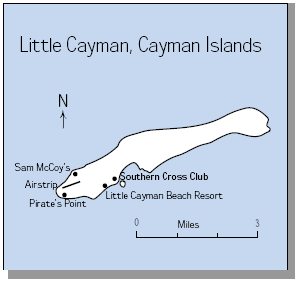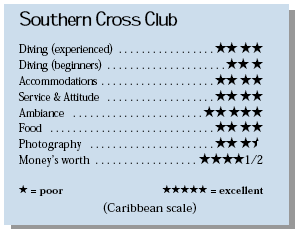Southern Cross Club, Little CaymanContents of this Issue: Southern Cross Club, Little Cayman The Answer to Inflatable Sharks Live by the Internet Die by the Internet Editorial Office: Ben Davison Publisher and Editor Undercurrent 3020 Bridgeway, Suite 102 Sausalito, CA 94965 walls, boobies, bites and Bloody Bay from the August, 1999 issue of Undercurrent
I’d have given my hat and poncho for a picture of my wife’s face as the little Island Air plane that had ferried us the 90-mile stretch from Grand Cayman took off and disappeared. It had dropped us on Little Cayman’s gravel and grass strip after our 30-minute flight, and here we were, out in the middle of the mile-wide, 10-mile long island: hot, alone, insects buzzing, strong booby pond smells in the air. All the other resorts had picked up their people and driven off. “See," I said, "it’s just like I told you. Desolate. Nothing here. Nothing to do.” From the look on her face, I could see that really helped the situation. But it only took 10 minutes and a phone call from the guy at Island Air before Pete Hillerbrand, the apologetic owner of the Southern Cross Club, drove by to pick us up, and five minutes later we were checking in. I really did think when I booked my Little Cayman trip that there was nothing except diving to do there. But when I arrived, I found a few other things to add to my list: there were birds to watch, bikes to ride, sea kayaks to paddle around in the lagoon, a little snorkeling at Owen’s Island just a short kayak-paddle from Southern Cross. Point of Sand on the island’s tip is the only place to shore dive on Little Cayman, and you have to be driven to the site. But there’s boat diving a-plenty: three a day, excellent fish life, and walls that rank among the best in the Caribbean, a shade better than the best walls in the Turks and Caicos, a shade below my favorite Puerto Rican heart-stoppers (described in my April 1999 Undercurrent article). When my giant stride off the wide dive platform plunged
me into the 83° water at Coconut Walk, I knew I’d discovered
a new favorite. Southern Cross Club itself is less country club than adult summer camp, designed by folks interested in casual comfort and not glitz. It’s not Architectural Digest beautiful, but it’s pretty and well laid out, designed around a clubhouse with dining room, sitting room, bar, outside bar, and gift shop. All the bungalows are on the beach; mine had a little palm-shaded picnic table outside my front door that became my morning coffee spot. There’s a nice pool, although it was hardly refreshing; it was so hot that the water was hot-tub-esque. The dock had been rebuilt recently to repair hurricane damage. I liked the style of my room: spacious, clean, and comfortable, with ample air conditioning supplemented by fans mounted on the high ceilings. The design was tasteful, the two beds and cozy chairs comfortable. Someone had paid attention to the thoughtful touches: a coffee maker, a few fresh flowers, room deodorant spray in the bathroom, even little pillows on the bed with “Welcome” on them. There was no shortage of outlets or drawer and closet space, either. Water pressure was a problem, though; the sink in the room was fine, but calling the nozzle in the bathroom a shower was a bit of a stretch. Each duplex bungalow had a porch common to both rooms, and the outdoor shower there had better pressure. A nearby clothesline was handy for wet things. Southern Cross Club was born as a gentlemen’s fishing camp in 1959, when Little Cayman boasted a population of 12. But Pete’s gutted those old poured concrete structures and rebuilt them almost from the ground up. Though you wouldn’t know it, Pete’s from a well-to-do midwestern family, but he heard a different drummer and decided to put his heart, soul, and money into Southern Cross and work hard. Work he does: I saw him tending bar and bussing dishes, but there’s still something of the well-educated midwestern frat boy about him, one who’s invited you to his party. He runs the place that way, so it’s a fun place to stay. I loved the isolation. I knew we were on a small island with half a dozen other resorts, but Camp Southern Cross seemed like my camp: 20 guests (all Americans except for one Argentinean couple) staying in 10 rooms in five bungalows. Pete and Jon, the general manager (formerly boat captain at SCC and aboard Little Cayman Diver II), make the place fun. Pete does an excellent job yet has a light touch, and the staff reflects that attitude. There’s low staff turnover and a high level of performance. One problem with being at SCC in June was the night insect madness. There’d be no problem all day, then at sundown clouds of flying bugs that annoy or bite. Make sure that the 55 pounds of stuff you bring includes bug juice. Worst of all was the fearsome coconut bug, which had a very acidic exoskeleton. When a coconut bug lands on you, brush it off, don’t smack it. If you do, it mushes on your skin, and it burns. My arm has a souvenir scar (tiny, but a scar) courtesy of a coconut bug. One poor guy, who just couldn’t get the hang of flicking versus smashing, had wounds on his face. I’m the type who’d have serious reservations about going somewhere sand-flea laden, and the bugs took some of the luster off early evenings. The “bug spray/flick/don’t smack” program combined with retiring to my cozy island bungalow after dinner made the bugs almost a non-issue. Getting up early, doing three a day: it’s an early-to-bed kind of place. Hard-core night owls went inside the clubhouse, drank at the inside bar, and watched cable TV. Few bugs followed. The dive team is Terry, Bert, and occasionally Jason (when he’s not tending
bar). Novice divers might prefer more guidance and supervision. A few times I thought less-experienced divers could have been watched more closely. On one dive, for example, 3 out of 12 divers were novices, but no divemaster swam “sweep,” and one of the novices kept swimming into the blue. But the diving is generally simple: no seas (though one day brought huge 6" swells), great viz (usually about 100’), and dives that often ended over 15 - 20' bottoms. Walls are sheer, and there’s always about 3000’ of blue water off the wall. The daily routine was simple. Start with breakfast at 7:30: banana pancakes, eggs Benedict, scrambled eggs, and a buffet with juice, fruit, cereal, and the like. Most days we’d be on the boat at 8:30, and once I’d set up my gear on an aluminum 80 for the first dive, I never set it up again. My boat, Lucky Star, was a newly acquired 36-footer with a 14-foot beam and no engine hump, a real beauty that was a pleasure to dive from, like being on the hanger deck on an aircraft carrier. The other 36-footer is more modest but comfortable. Both boats are halfcovered and roomy and have nice-sized dive platforms and ladders. There’s fresh water to drink, cut-up fresh fruit for snacks, fresh-water showers, and a freshwater tank for cameras. After two morning dives, the boat comes back for lunch, which might be grilled ham and cheese, chicken curry salad, or burritos and tacos on Mexican day. All were tasty, although the clubhouse and dining room aren’t air conditioned, so in the June heat we were all drenched with sweat as we ate. We could have used more than a few fans. Then, after a brief stretch in the hammock, the boat went out again at 2:30 for a single-tank dive. We’d be back by 4 or 4:30, which left me time for schmoozing around the pool and the outdoor bar before dinner around 7:30. We had a choice between two dinner alternatives, one usually a vegetarian option like stuffed squash or mushroom and vegetable quiche. Other options included BBQ spare ribs, spaghetti, ribeye steaks, spicy jerked chicken with peas and rice, and grilled tuna with mango salsa. The food wasn’t 5-star, but it was consistently good. However, I couldn’t really hunker down to a great dining experience when I was hot and sweating and I knew it was 10° cooler outside. Little Cayman’s walls are among the best in the Caribbean. With the bulk of the dive sites moored and lined up in a row, leading dives is pretty simple, so what matters is the quality of the dive operation. I was more than satisfied with SCC’s. The week’s dives were all at Bloody Bay or Jackson Bay, where there was a little current. Local dive operations follow the unwritten rule that if another boat is on a mooring, your boat goes someplace else, which keeps sites uncrowded. Bloody Bay has sandy bottoms at about 20', then after a short swim the wall makes a 90° nose dive and plunges vertically. Jackson is hard pan at a slight angle, then a big plunge. Fifteen of my 17 dives were wall dives. Most dives ended back in the shallows, where I spent my 5-minute safety stops exploring instead of hanging. Terry and Bert gave great briefings: good information about what to look for mixed with humor and a bit of story-telling on the boat before the dives. My log book is filled with well-known sites from the week: Marilyn’s Cut, Mike’s Mount, Nancy’s Cup of Tea, Mixing Bowl, and all were great. At Mixing Bowl I swam along a shallow sandy bottom to the edge of the wall. I was greeted by huge schools of wrasse, blue chromis, and black durgons. My wife is a big French angel fan, and a few of her friends were there. Turtles abound on Little Cayman. I had the opportunity to watch them swim by, rocket to the surface for air and a jellyfish lunch (no DCS for them!), then float back down to whiz past me. At one point I got a great snapshot for my mental video camera when a turtle and a ray swept past and did a 90° turn in front of me. The week also provided lots of social opportunities with grouper and huge schools of jacks and wrasse. The walls are filled with sponges and coral; though there was occasionally a little algae or coral bleaching, most of the coral was brilliant and healthy. The tube sponges on the wall were numerous and, in cases, huge. The walls aren’t especially colorful, but there’s lots of soft and hard coral. Although one or two of the dives were “okay,” the rest were great or better. I was lucky to see pairs of turtles, Ben the Grouper (he lives at Marilyn’s Cut and loves to be petted), two huge lobsters duking it out for the same hole, a pregnant lobster sitting in a huge barrel sponge, and perhaps 60% of the fish on my Caribbean fish I.D. card. There are a few bad memories, like sea lice. Most dives on Little Cayman finish up in shallow water, and the stingy-thingies are there. (For info on avoiding and treating sea lice stings (or, in medical parlance, Sea Bather’s Eruption), see the May, 1998, issue of Undercurrent.) Being a tee-shirt diver, I make myself more vulnerable, but a few other divers got the itch. It’s part of summer diving on Little Cayman. But, frankly, I’d jump back in the water today and itch a little more in exchange for the awesome diving. However, most of my mental snapshots are great ones, like a gargantuan basket and 5'+ elephant-ear sponges at 100' at Marilyn’s Cut; grouper pulling up to cleaning stations like Volkswagens at a car wash; wonderful swims with turtles; swimming back up to the top of the wall and seeing clouds of jacks or grunts or chubs or wrasse hanging there; and the mind-blowing scale of the walls highlighted by beautiful relief features. It is great Caribbean diving. — K. B.
|

I want to get all the stories! Tell me how I can become an Undercurrent Online Member and get online access to all the articles of Undercurrent as well as thousands of first hand reports on dive operations world-wide
| Home | Online Members Area | My Account |
Login
|
Join
|
| Travel Index |
Dive Resort & Liveaboard Reviews
|
Featured Reports
|
Recent
Issues
|
Back Issues
|
|
Dive Gear
Index
|
Health/Safety Index
|
Environment & Misc.
Index
|
Seasonal Planner
|
Blogs
|
Free Articles
|
Book Picks
|
News
|
|
Special Offers
|
RSS
|
FAQ
|
About Us
|
Contact Us
|
Links
|
3020 Bridgeway, Ste 102, Sausalito, Ca 94965
All rights reserved.

 It was the relief features that first caught my eye, big cuts in the sheer
wall and curvature that gave some
perspective to the immensity. The top
of the wall was spangled with huge
schools of wrasse and grunts, the wall
itself laden with healthy coral and
sponges, including an enormous barrel
sponge. As I swam deeper, the cuts,
overhangs, curves, and shelves I could
see within my 100' visibility were
amazing. At one point in the dive I
witnessed something I’d never seen
before: male and female wrasse swimming
in separate tight groups, then
exploding in a dance-like upward motion
that could only be wrasse sex. I
came back over the top of the wall to
where a series of half-a-dozen miniwalls
ran out to the big wall, spotting
five lobsters as I swam from
mount to mount over the sandy bottom. The dive ended over a 15' - 20' bottom.
With no seas the boat almost stood still as I approached the ladder, grabbed
hold, and lazily took off my fins. A crew member took my tank. This was country
club diving.
It was the relief features that first caught my eye, big cuts in the sheer
wall and curvature that gave some
perspective to the immensity. The top
of the wall was spangled with huge
schools of wrasse and grunts, the wall
itself laden with healthy coral and
sponges, including an enormous barrel
sponge. As I swam deeper, the cuts,
overhangs, curves, and shelves I could
see within my 100' visibility were
amazing. At one point in the dive I
witnessed something I’d never seen
before: male and female wrasse swimming
in separate tight groups, then
exploding in a dance-like upward motion
that could only be wrasse sex. I
came back over the top of the wall to
where a series of half-a-dozen miniwalls
ran out to the big wall, spotting
five lobsters as I swam from
mount to mount over the sandy bottom. The dive ended over a 15' - 20' bottom.
With no seas the boat almost stood still as I approached the ladder, grabbed
hold, and lazily took off my fins. A crew member took my tank. This was country
club diving. Terry Thompson is a well-traveled, witty guy whose long dive career followed
stints as a chef and a social worker. The years haven’t dulled his enthusiasm;
he loves doing what he does and
he’s good at it. Bert’s newer and
younger, an introspective, solid sort
who goes out of his way to show you
stuff underwater. The 15-30 minute runs
to the dive sites with them were fun
and relaxed: a few people sunned themselves
and chatted on the bow; my raucous
group joked with the divemasters.
Both of them were accomplished at pushing
dive enjoyment to admirable levels,
but they’d let competent divers alone
to do their thing within reason and
Cayman Water Sports Assoc. guidelines
(which restrict first dives to 100'
(for 50 minutes and 500 psi) with second
and third dives 60 for 50).
Terry Thompson is a well-traveled, witty guy whose long dive career followed
stints as a chef and a social worker. The years haven’t dulled his enthusiasm;
he loves doing what he does and
he’s good at it. Bert’s newer and
younger, an introspective, solid sort
who goes out of his way to show you
stuff underwater. The 15-30 minute runs
to the dive sites with them were fun
and relaxed: a few people sunned themselves
and chatted on the bow; my raucous
group joked with the divemasters.
Both of them were accomplished at pushing
dive enjoyment to admirable levels,
but they’d let competent divers alone
to do their thing within reason and
Cayman Water Sports Assoc. guidelines
(which restrict first dives to 100'
(for 50 minutes and 500 psi) with second
and third dives 60 for 50).  Diver’s Compass: Southern Cross Club: phone 800-899-2582 or 345-
948-1099; fax 345-948-1098; website
Diver’s Compass: Southern Cross Club: phone 800-899-2582 or 345-
948-1099; fax 345-948-1098; website 